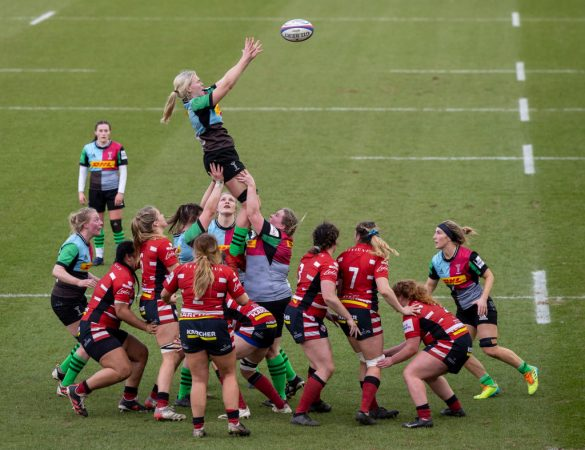World Rugby is continually looking for new ways to make the game better. Despite rugby being professional for over 25 years now, there are still a lot of new rules being introduced.
What is the 22-50 rule in rugby? If an attacking player kicks the ball from inside their own half (50 metres) out of play inside the opposition’s 22 metre line with a bounce then the attacking team will get the throw-in. This rule is known as the 50-22 rule (Fifty Twenty Two). The 50:22 rule was introduced by World Rugby on the 1st August 2021.

The 22-50 rule is actually known as the 50-22 rule and it has only been introduced to the sport in the last couple of years. The rule says that if an attacking team kicks the ball out of play in the opponent’s 22 from their own half with one bounce then it will be a lineout for the attacking team (the team that kicked the ball).
In any situation other than a penalty, this would have usually been the defending team’s throw-in at the lineout because the attacking team were the team to kick the ball out. However, World Rugby were looking for a way to give the attacking team more opportunities to use the boot.
There are a couple of exceptions to the rule. For one thing, the ball has to bounce before going out of play. If the ball goes out on the full then the 50-22 rule does not apply and the lineout will be taken from inline of where the ball was kicked from. The other exception is to do with the attacking team taking the ball into their half.
If the attacking team takes the ball into their own half then it does not count as a 50-22 if they decided to go for the kick. The ball has to have gotten into the attacking team’s half without the attacking team taking it in themselves.
Why did they put in the 50-22 rule?
There are two main reasons why the 50-22 rule was introduced, the first is the direct effect of the rule. Introducing the rule means there are more opportunities for an attacking team to get into a great position to score a try. Rugby is trying to make the sport more attacking and exciting, with the 50-22 rule allowing attacking teams to take a risk by kicking for a great attacking opportunity.
The other is the indirect effect of the rule. Defending teams will be worried about conceding a 50-22. This means that they are much more likely to pull defenders out of the line to protect against the 50-22 rule by defending the side-lines. This will reduce the number of defenders in the line and gives the attacking teams more opportunities when they get the ball wide.
By introducing this rule, the attacking team has a greater advantage over the defending team, creating more attacking opportunities. This will help rugby become more attacking and exciting.
50-22 examples in rugby
Despite the 50-22 rule being only a couple of years old we have already seen some brilliant examples of the rule in action.
Andrew Conway vs England 2022
Irish winger Andrew Conway unleashed an incredible kick during the 2022 Six Nations. He managed to pick up a bouncing ball inside his own 22 before launching a kick only a couple of metres out from the sideline. It was a monstrous kick and managed to bounce into England’s 22 and out of play.
Thanks to the ball bouncing out in England’s 22, Ireland were awarded the lineout and it gave them a great opportunity for a try to be scored.
Ben Meehan vs Saracens 2023
Former Australian Under-20 scrum-half Ben Meehan has been a very consistent player with Gloucester since joining the team in 2021. He was under a lot of pressure at the start of 2023 with league leaders Saracens rolling into town.
In the 59th minute, Meehan set up for a box kick inside of his own 22. With a couple of yards of space, Meehan took those steps and kicked the ball downfield. He got such a good connection on the ball that the Gloucester fans watched as the ball trickled inside the opposition 22 and eventually rolled out of play five metres out from Saracen’s tryline.
Thanks to Meehan being inside of his own half, Gloucester were awarded the lineout and had a brilliant attacking opportunity.
Peter O Mahony vs New Zealand 2022
It is rare we see forwards kicking the ball, but we have seen a few examples of forwards making the best out of the new 50-22 rule. Peter O’Mahony was one of those players, helping Ireland to a historic series win in New Zealand.
After a turnover in the second test, O’Mahony launched a pretty ugly-looking kick from Ireland’s own half. The ball bounced inside the All Blacks’ 22 and Ireland were given a great attacking opportunity that eventually led to a penalty that helped Ireland to tie the series and set up the deciding game.
What does 22 mean in rugby?
In rugby, the 22 is the area between the goal line and the 22-metre line within each half. Both teams have their own 22 which they are trying to defend because the attacking team is trying to get into the opposition’s 22 to get to the try line. It is often a bad sign when a team cannot get out of their own 22.
The 22-metre line Is also used for dropkicks when the ball is grounded in the try line by the defending team after an unsuccessful penalty kick or drop goal. The 22 dropout rules have been changed massively over the last few years, with the goal line dropout being introduced.
What does 50 mean in rugby?
The 50 in rugby refers to the halfway line. It is where play restarts at the beginning of both halves or after points are scored. It is also the line that the kicker has to be behind if they want to kick a 50-22. Each team defends one-half of the field.
